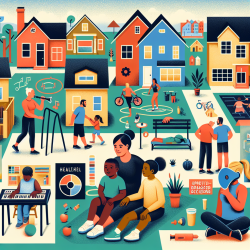Introduction
As speech-language pathologists, our primary goal is to foster optimal communication outcomes for children. However, it's crucial to recognize that factors beyond the therapy room can significantly influence these outcomes. The research article "Neighborhood Context, Homeownership and Home Value: An Ecological Analysis of Implications for Health" provides valuable insights into how environmental factors, such as neighborhood context and homeownership, can impact health outcomes. By understanding these factors, practitioners can enhance their approach and advocate for broader changes that support children's development.
Understanding the Research
The study focuses on the Detroit Metropolitan Area and examines the relationship between neighborhood racial composition, homeownership, and health outcomes. Key findings indicate that neighborhoods with a higher percentage of non-Hispanic Black (NHB) residents tend to have lower homeownership rates and lower home values, which are associated with poorer health outcomes, including higher mortality and disability rates.
These findings are significant because they highlight the role of socio-economic and racial disparities in health outcomes. For speech-language pathologists, understanding these disparities is crucial as they can indirectly affect children's communication development and overall well-being.
Implications for Practice
Here are some ways practitioners can use these insights to improve their practice:
- Advocate for Holistic Approaches: Recognize that children's communication challenges may be influenced by broader socio-economic factors. Advocate for holistic approaches that consider these factors in intervention planning.
- Collaborate with Community Resources: Engage with community organizations and resources that address housing and socio-economic disparities. This collaboration can help provide comprehensive support to families.
- Educate and Empower Families: Educate families about the potential impact of neighborhood and homeownership factors on their children's development. Empower them with resources and strategies to mitigate these effects.
- Data-Driven Advocacy: Use data from studies like this to advocate for policy changes that promote equitable access to quality housing and resources. Highlight the connection between stable housing and positive health outcomes.
Encouraging Further Research
While this study provides valuable insights, it also raises questions that warrant further exploration. For instance, how do these neighborhood factors specifically impact language development in children? What role do schools and educational resources play in mitigating these effects? Encouraging further research in these areas can lead to more targeted interventions and policies that support children's development.
Conclusion
By understanding the broader environmental factors that influence health outcomes, speech-language pathologists can enhance their practice and advocate for systemic changes that support children's communication development. To read the original research paper, please follow this link: Neighborhood Context, Homeownership and Home Value: An Ecological Analysis of Implications for Health.










